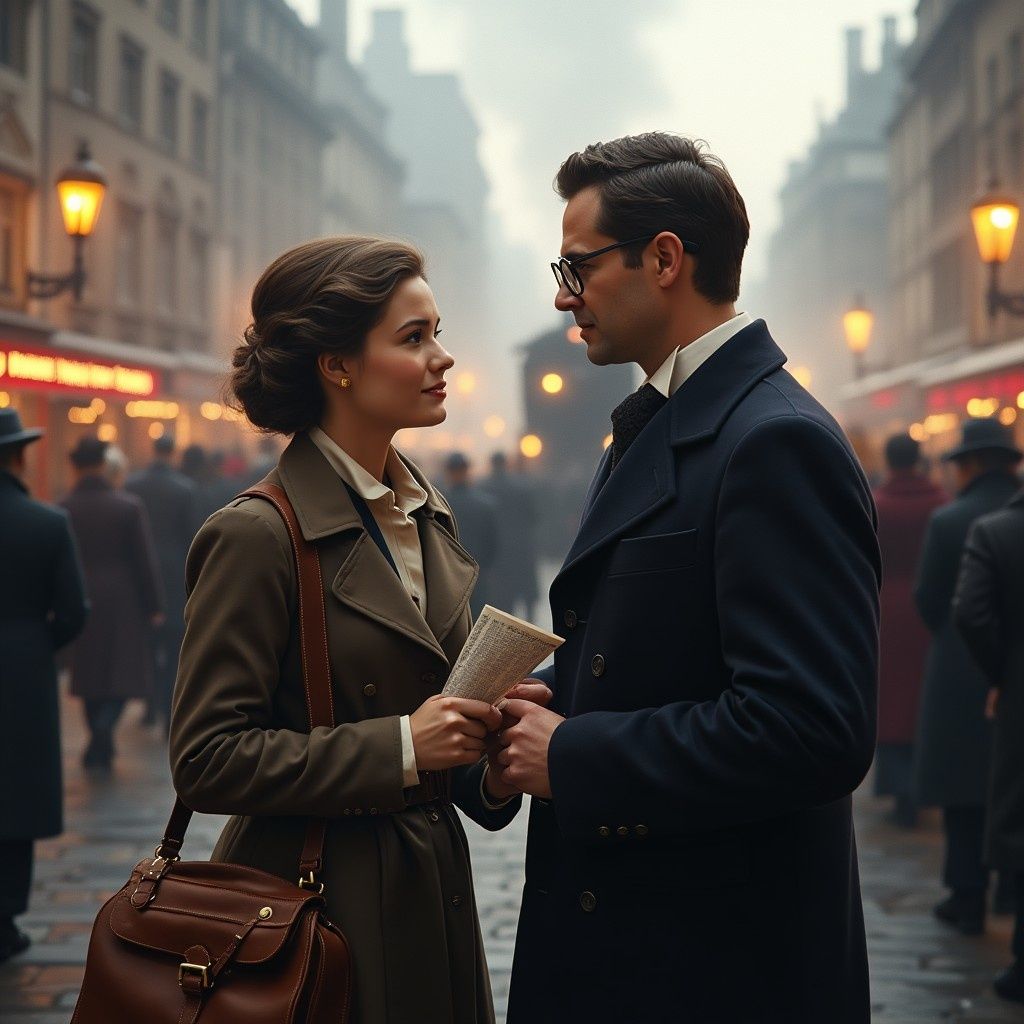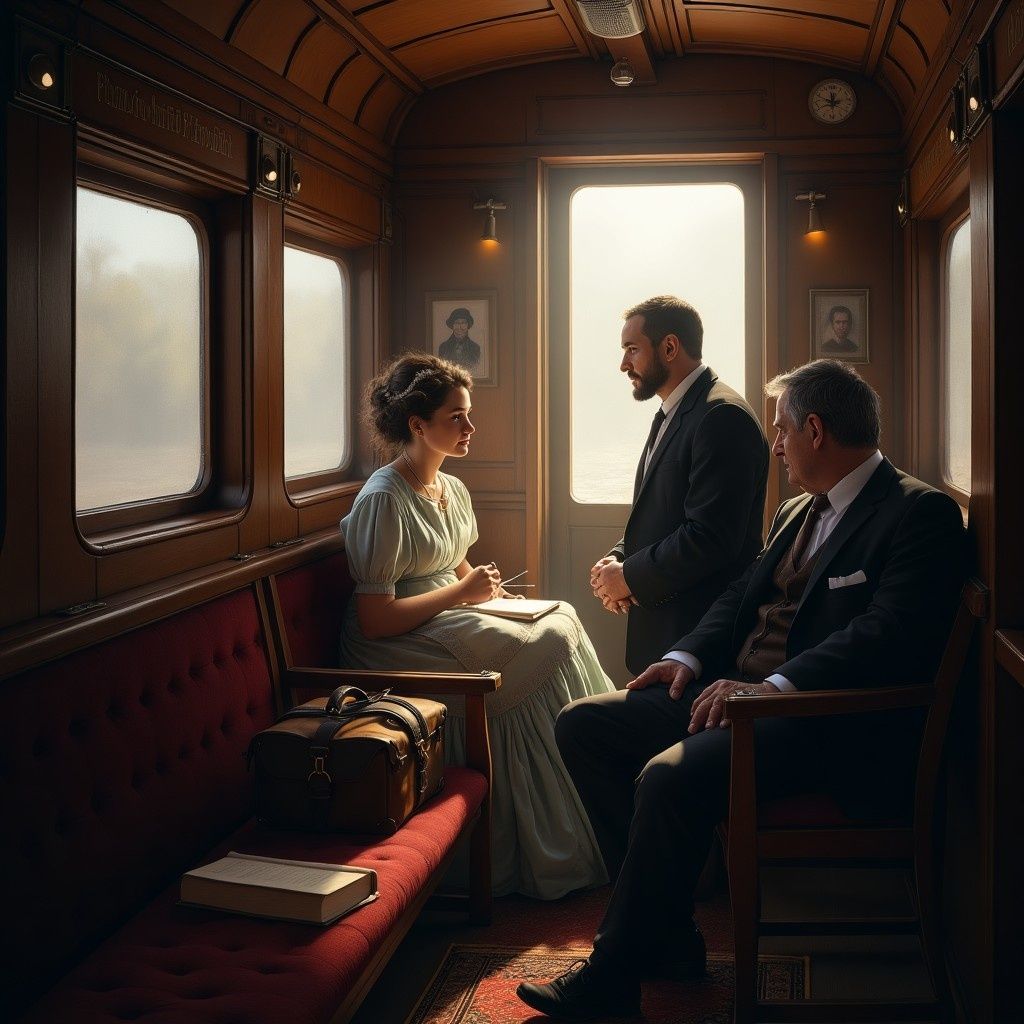Title: "Beneath the Cobblestones"
The gas lamps flickered in the early morning mist, casting a soft glow over the bustling streets of London. It was January 10, 1863, and the city was on the cusp of transformation. Crowds gathered, their breath visible in the cold air, as they awaited the inaugural journey of the Metropolitan Railway.

Among them stood Eliza Harrington, a young woman with a fire in her eyes and a heart full of dreams. Eliza clutched her worn leather satchel, feeling the weight of her aspirations within it. She was a journalist, determined to document this historic day for the "London Gazette." Her editor had been skeptical, dismissing the railway as a folly, but Eliza saw it differently. She saw it as a symbol of progress, a harbinger of change. Beside her, a man in a tailored coat adjusted his spectacles. Charles Pearson, the visionary behind the railway, exuded an air of quiet confidence. He had fought tirelessly for this moment, championing the project amidst skepticism and scorn. His eyes met Eliza's, and he offered a nod of recognition. They had met once before, at a gathering of like-minded reformers, and she had been struck by his unwavering belief in the power of innovation. As the steam locomotive approached, a cheer rose from the crowd.

The engine hissed and puffed, a mechanical beast ready to devour the distance between Paddington and Farringdon. Eliza boarded the wooden carriage, her heart pounding with anticipation. The air inside was thick with the scent of coal and ambition. Seated across from her was John Fowler, the engineer whose genius had brought the railway to life. His hands were calloused, a testament to years of labor and dedication. He glanced at Eliza, a hint of a smile playing on his lips. "A marvel, isn't it?" he remarked, his voice a blend of pride and humility. Eliza nodded, her pen poised over her notebook. "Indeed, Mr. Fowler. It's the dawn of a new era." The train lurched forward, and the passengers swayed with the motion. As they descended into the darkness of the tunnel, Eliza felt a thrill of excitement. The world above faded away, replaced by the rhythmic clatter of wheels on tracks. She imagined the possibilities that lay ahead, the new neighborhoods that would spring up, the lives that would be changed. But beneath her excitement lay a current of unease. She thought of the workers who had toiled in the damp, dangerous tunnels, their sacrifices hidden beneath the city's cobblestones. She thought of the skeptics who still doubted the railway's potential, clinging to the past with stubborn resolve. As the train emerged into the light at Farringdon, Eliza felt a surge of hope. The journey had been brief, but its impact would be lasting. She turned to Pearson, who stood by the carriage door, his gaze fixed on the horizon. "What do you see, Mr. Pearson?" she asked, her voice steady. He smiled, a vision of the future in his eyes. "I see a city unbound, Miss Harrington. A city where distance is no longer a barrier, where dreams can take root and flourish."

Eliza scribbled his words in her notebook, her heart swelling with the promise of what was to come. As the passengers disembarked, she lingered on the platform, watching the steam rise and dissipate into the morning air. In that moment, she understood the true significance of the Metropolitan Railway. It was more than a feat of engineering; it was a testament to human ingenuity and resilience. It was a story she was determined to tell, a story of passion and progress, of dreams realized beneath the cobblestones of London. With renewed purpose, Eliza stepped into the bustling streets, ready to capture the unfolding drama of a city transformed.

Among them stood Eliza Harrington, a young woman with a fire in her eyes and a heart full of dreams. Eliza clutched her worn leather satchel, feeling the weight of her aspirations within it. She was a journalist, determined to document this historic day for the "London Gazette." Her editor had been skeptical, dismissing the railway as a folly, but Eliza saw it differently. She saw it as a symbol of progress, a harbinger of change. Beside her, a man in a tailored coat adjusted his spectacles. Charles Pearson, the visionary behind the railway, exuded an air of quiet confidence. He had fought tirelessly for this moment, championing the project amidst skepticism and scorn. His eyes met Eliza's, and he offered a nod of recognition. They had met once before, at a gathering of like-minded reformers, and she had been struck by his unwavering belief in the power of innovation. As the steam locomotive approached, a cheer rose from the crowd.

The engine hissed and puffed, a mechanical beast ready to devour the distance between Paddington and Farringdon. Eliza boarded the wooden carriage, her heart pounding with anticipation. The air inside was thick with the scent of coal and ambition. Seated across from her was John Fowler, the engineer whose genius had brought the railway to life. His hands were calloused, a testament to years of labor and dedication. He glanced at Eliza, a hint of a smile playing on his lips. "A marvel, isn't it?" he remarked, his voice a blend of pride and humility. Eliza nodded, her pen poised over her notebook. "Indeed, Mr. Fowler. It's the dawn of a new era." The train lurched forward, and the passengers swayed with the motion. As they descended into the darkness of the tunnel, Eliza felt a thrill of excitement. The world above faded away, replaced by the rhythmic clatter of wheels on tracks. She imagined the possibilities that lay ahead, the new neighborhoods that would spring up, the lives that would be changed. But beneath her excitement lay a current of unease. She thought of the workers who had toiled in the damp, dangerous tunnels, their sacrifices hidden beneath the city's cobblestones. She thought of the skeptics who still doubted the railway's potential, clinging to the past with stubborn resolve. As the train emerged into the light at Farringdon, Eliza felt a surge of hope. The journey had been brief, but its impact would be lasting. She turned to Pearson, who stood by the carriage door, his gaze fixed on the horizon. "What do you see, Mr. Pearson?" she asked, her voice steady. He smiled, a vision of the future in his eyes. "I see a city unbound, Miss Harrington. A city where distance is no longer a barrier, where dreams can take root and flourish."

Eliza scribbled his words in her notebook, her heart swelling with the promise of what was to come. As the passengers disembarked, she lingered on the platform, watching the steam rise and dissipate into the morning air. In that moment, she understood the true significance of the Metropolitan Railway. It was more than a feat of engineering; it was a testament to human ingenuity and resilience. It was a story she was determined to tell, a story of passion and progress, of dreams realized beneath the cobblestones of London. With renewed purpose, Eliza stepped into the bustling streets, ready to capture the unfolding drama of a city transformed.
The Metropolitan Railway, known as the Met, was the world's first underground passenger railway, opening on January 10, 1863, in London. Initially connecting Paddington to Farringdon, it used steam locomotives and gas-lit wooden carriages. The railway played a crucial role in London's expansion, stimulating suburban development in areas like Middlesex. Key figures included Charles Pearson, who championed the project, and John Fowler, the engineer. The Met's significance lies in its pioneering underground transit, which laid the groundwork for modern urban rail systems and transformed London's urban landscape, eventually becoming part of the London Underground network.


Comments
Post a Comment